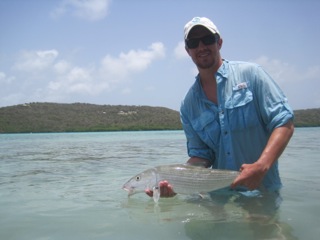
THE PROJECT
Culebra, a small island to the east of Puerto Rico, is notorious among seasoned anglers for its unusually large bonefish. However anecdotal evidence suggests that bonefish populations inhabiting relatively small, isolated, reef flats such as those found on Culebra may be particularly vulnerable to human-induced disturbances such as illegal gill netting and habitat loss.
To learn about their potential vulnerability, an international team of researchers launched a multi-year study examining the movement patterns of bonefish in Culebra. In the summer of 2012 we began by creating a research infrastructure in Culebra, and deployed an array of nearly 50 acoustic receivers (listening stations) encompassing the entire island, allowing us to detect tagged bonefish and follow their movements at scales as small as a few yards!
After months of testing and fine-tuning, we deployed an initial batch of tagged bonefish and the preliminary data is amazing. Based on this test of the array, we planned to surgically implant transmitter tags into 30 bonefish in the spring of 2013, collecting data on their movements well into 2015!
THE PROBLEM
Due to spending cutbacks by the U.S. federal government, the grant that made this work possible has been cut by half. This means we can barely afford to maintain our infrastructure and network of listening stations, and most importantly, that we can no longer afford to purchase and deploy 30 transmitter tags this spring as planned. In other words, 30 bonefish will be swimming around our extensive array of listening stations in Culebra without any transmitter tags in them, providing us with NO DATA!
HOW YOU CAN HELP
Adopt a Culebra Bonefish! We need to raise $19,500 for 30 transmitters to implant in bonefish, with purchase and deployment of each tag costing $650. Please consider Adopting a Bonefish as part of this project. As a thank-you, we will name the bonefish tagged in your honor, and you’ll receive a thank-you packet, including a photograph of the bonefish and its personal details, (length, weight, sex when known), as well as bi-yearly updates on their fish’s status!
Don’t let Culebra’s bonefish go another season without providing us with valuable information about how to conserve them! Adopt a Culebra bonefish now!
Time is of the essence!
Contact Dr. Andy Danylchuk (danylchuk@eco.umass.edu) to adopt your bonefish today.
 Monday, February 25, 2013 at 12:04AM
Monday, February 25, 2013 at 12:04AM  Can you see me now?
Can you see me now? andy danylchuk,
andy danylchuk,  bonefish,
bonefish,  bonefish & tarpon trust,
bonefish & tarpon trust,  fish science in
fish science in  Science,
Science,  Species
Species 







